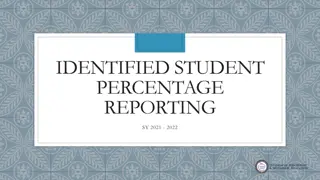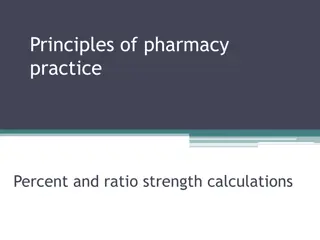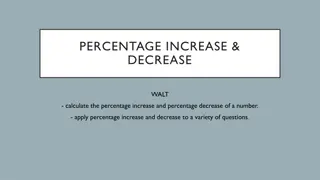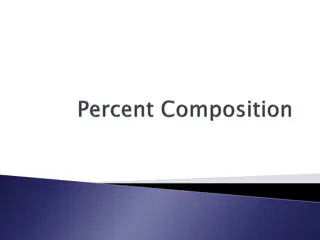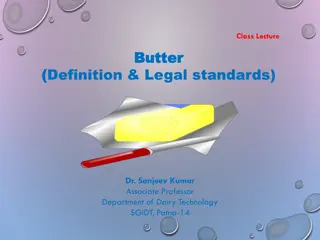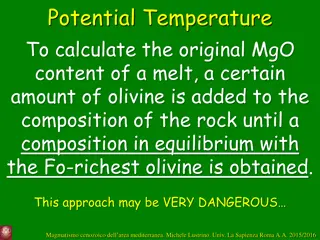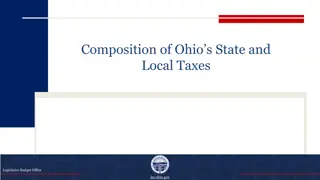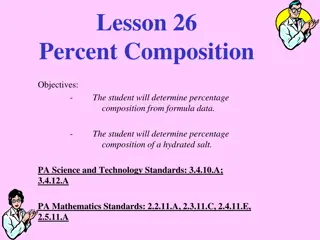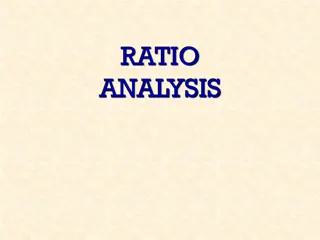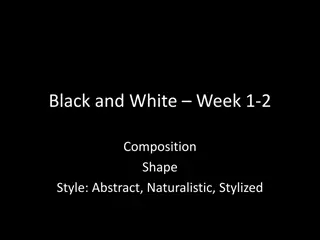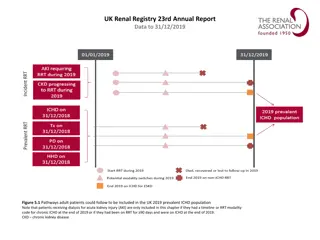Exploring the Composition of Earth's Oceans
Delve into the composition, location, and subsurface topography of the world's oceans, discovering the chemical makeup of ocean water and its vast salt content. Uncover fascinating facts such as how the salt in the oceans could create a 500-foot thick layer if spread over Earth's land surface. Engag
2 views • 16 slides
Principles of Architecture: Unity, Contrast, Mass Composition
Explore the fundamental principles of architecture focusing on unity, contrast, and mass composition. Unity emphasizes harmony among building elements, contrast adds interest without disrupting unity, and mass composition involves arranging shapes in a harmonious way. Proportion and scale play key r
0 views • 24 slides
Understanding Green Chemistry Principles and Efficiency in Chemical Processes
Green chemistry focuses on designing sustainable chemical products and processes to minimize hazardous substances. It advocates for waste prevention, efficient reactions, and use of raw materials. Chemical engineers play a key role in optimizing percentage yield and atom economy for efficient produc
0 views • 49 slides
Understanding Atmosphere Composition and Structure in Climatology
The study of climatology, focusing on the atmosphere, is presented by Dr. Banashree Saikia, covering topics such as atmospheric composition, insolation, temperature variations, atmospheric pressure, wind systems, atmospheric moisture, climatic classification, cyclones, and monsoons. The atmosphere,
1 views • 9 slides
Identifying Student Percentage Reporting SY 2021 - 2022
Identified Student Percentage Reporting (ISP) is essential for districts to report the number of students identified through direct certification and categorical lists in eSchool. This report must be submitted by April 15, 2022, to comply with federal regulations. Understanding how ISP is calculated
1 views • 12 slides
Pharmacy Practice: Percentage and Ratio Strength Calculations
Understanding percentage and ratio strength calculations is crucial in pharmacy practice. Percentages can be expressed as fractions or decimals, and various concentrations like weight-in-volume and volume-in-volume are used in pharmaceutical preparations. Learn how to calculate the correct strength
0 views • 24 slides
Nutritive Value and Composition of Eggs by Dr. Sushma Kumari
The composition and nutritive value of eggs, as presented by Dr. Sushma Kumari from Bihar Animal Sciences University, cover various aspects including the physical composition of eggs, the composition of an eggshell, and the chemical composition of eggs. The presentation delves into details such as t
0 views • 19 slides
Understanding the Composition of Earth's Interior: Insights from Density, Pressure, and Temperature
The constitution of the Earth's interior plays a crucial role in shaping the surface features we observe. Although direct observation is challenging, seismic studies offer valuable insights. The density, pressure, and temperature within the Earth provide essential clues to its composition. Rocks' de
0 views • 14 slides
Financial Data Analysis and Visualization Overview
Analyzing the financial data provided, we observe various amounts with corresponding percentage values. These values range from $2,832.00 to $54,900.00, each associated with a specific percentage. The data entails a mix of numeric values and percentages, offering insight into different categories of
0 views • 2 slides
Understanding Percentage Increase and Decrease in Mathematics
Explore the concepts of calculating percentage increase and decrease of a number, applying these calculations to various scenarios, and mastering the skills to find any percentage of any amount. Test your knowledge with quick exercises and delve into using strategies to complete tables for practice.
1 views • 24 slides
Understanding the Physico-Chemical Properties of Cream
This informative material delves into the physico-chemical properties of cream, covering aspects such as viscosity, whipping quality, titratable acidity, specific gravity, and factors influencing viscosity. It discusses the influence of fat content, temperature, homogenization, cooling, aging, and c
0 views • 8 slides
Understanding Environmental Hygiene: Air Pollution and Composition of Air
The content delves into the concept of atmospheric pollution, the composition of pure and impure air, sources of air pollution, and the zones of the atmosphere. It highlights the detrimental effects of pollutants on health and the environment, emphasizing the importance of environmental hygiene. The
1 views • 27 slides
Understanding Percent Composition and Empirical Formulas in Chemistry
The Law of Definite Proportions governs the composition of compounds based on molar masses, allowing us to calculate percentage compositions of elements within a compound. Through examples involving various compounds like Fe3C, sulfur dioxide, ammonium nitrate, glucose, and acetic acid, we explore t
4 views • 7 slides
Understanding Moles and Formula Mass in Chemistry
Dive into the world of moles, Avogadro's number, and formula mass calculations in chemistry. Learn how to convert moles to grams, grams to moles, and determine the number of atoms using Avogadro's number. Explore the concepts of formula mass and percentage composition to understand the composition o
0 views • 19 slides
Understanding Butter: Definition, Standards, and Composition
Explore the definition of butter according to FSSAI standards, including its composition, permitted additives, and classifications based on acidity, salt content, end-use, and manufacturing practices. Discover the nutritional composition and fatty acid profile of butter along with essential informat
0 views • 10 slides
The Share Percentage System for Mobility in ASEM Context
Exploring the Share Percentage System for mobility in the context of ASEM, this article emphasizes the importance of common credit transfer systems and lessons learned from EU-SHARE. The system is based on aligning national qualification frameworks, comparability of study program learning outcomes,
0 views • 28 slides
Mastering Percentage Changes: Examples and Practice
Dive into the world of percentage changes with worked examples and practice scenarios. Learn how to calculate percentage changes from original values to new values, sharpen your skills, and gain confidence in handling percentage calculations. Explore various scenarios with different numerical values
0 views • 4 slides
Secure Composition of Key Exchange Protocols
Explore the game-based composition approach for key exchange protocols, focusing on ensuring security in compositions with arbitrary tasks and the universal composability of protocols. Delve into the Bellare-Rogaway security model and the details of security games in protocol analysis. Understand ke
0 views • 25 slides
Understanding Chemistry and Composition in the Climate System
Dive into the intricate relationship between chemistry and composition in the climate system, exploring topics such as radiative effects, stratosphere-troposphere coupling, aerosol-cloud interactions, and the impact of various gases and particulates on radiative forcing. Discover how changes in comp
0 views • 25 slides
Understanding Soil Composition and Importance
Explore the world of soil and its significance as a natural resource by discovering its composition and how it affects plant growth. Learn about the main ingredients of soil, its permeability, and the role of water, air, and organic matter. Gain insights into how soil supports plant life through lea
1 views • 30 slides
Comprehensive Guide to Nutritional Value and Composition of Vegetables
Vegetables are herbaceous edible plants cultivated for consumption in various forms like fresh, cooked, or as salads. They are rich in essential nutrients such as protein, carbohydrates, vitamins, and inorganic salts. The tables provided detail the main nutrient constituents and composition of vario
1 views • 25 slides
Understanding Olivine Equilibrium in Calculating Original Magma Composition
The process involves analyzing olivine in basaltic rocks, selecting olivine with the highest Fo content, calculating the melt composition in equilibrium with this olivine using the distribution coefficient (KD), and determining the potential temperature (Tp) based on the MgO content. The distributio
0 views • 30 slides
Understanding Concentration of Solutions in Physiology
Concentration of solutions is crucial in understanding the properties of substances in Physiology. This involves concepts like percentage solutions and molar solutions, where the amount of solute is measured in grams or moles relative to the volume of the solution. Percentage solutions are commonly
0 views • 8 slides
Soil Chemistry and Mineralogy Analysis at CSU Summer Soil Institute
Explore the comprehensive analysis of soil chemistry, texture, and mineralogy conducted at the CSU Summer Soil Institute in July 2010. The study delves into pedology, elemental composition, particle size distribution, X-ray diffractometry, and mineralogical composition of various soil samples. Detai
0 views • 22 slides
Repeated Percentage Change Challenges
Explore various scenarios involving repeated percentage changes such as sales, investments, savings, and value depreciation. Test your math skills with calculations, understanding multipliers, predicting outcomes, and debunking misconceptions. Challenge yourself with practical examples to master the
0 views • 8 slides
Composition of Ohio's State and Local Taxes Revealed
Ohio relies heavily on sales taxes for state and local government tax revenue. In FY 2019, Ohio's combined state and local tax revenue sources included property taxes, individual income tax, and sales taxes. Sales taxes accounted for the highest percentage of revenue, followed by property taxes and
0 views • 4 slides
Understanding Body Composition: Types, Measurement Methods, and Impacts on Health
Body composition is a key aspect of overall health and fitness. It involves understanding different somatotypes - ectomorph, endomorph, and mesomorph, as well as distinguishing between lean body mass and body fat. Various methods such as underwater weighing, electrical impedance, skinfold measuremen
0 views • 26 slides
Understanding the Difference Between Aggregation and Composition in Object-Oriented Programming
Aggregation and Composition are two important concepts in object-oriented programming. Aggregation refers to a 'has-a' relationship where the contained object can survive independently, while Composition indicates that the member object is part of the containing class and cannot exist separately. Th
0 views • 15 slides
Understanding Percentage Composition in Chemistry
Percentage composition is crucial in determining the elemental composition of compounds. This lesson explains how to calculate percentage composition using molar masses, illustrated with examples like copper sulfide. It also delves into hydrated salts and their significance in chemistry. Students wi
0 views • 22 slides
Understanding the Composition Scheme under GST
The Composition Scheme under GST allows eligible taxpayers to pay a fixed percentage of their turnover as tax and enjoy simplified compliance requirements. This scheme comes with turnover limits, tax rates, and eligibility criteria for different categories of businesses. Learn about who can opt for
0 views • 12 slides
Understanding Percentages - Dr. Frost's Year 7 Math Lesson
Dive into the world of percentages with Dr. Frost in this lesson designed for Year 7 students. Learn how to calculate percentage changes, find percentages of amounts, and solve worded percentage problems. Practice your skills with quickfire questions and exercises to test your understanding. Explore
0 views • 21 slides
Understanding Repeated Percentage Changes in Sales and Investments
This content covers examples and calculations related to repeated percentage changes in sales and compound interest investments. It explains how prices are affected when all items are reduced by a certain percentage in sales, as well as scenarios involving compound interest investments over multiple
0 views • 17 slides
Understanding Ratio Analysis for Business Performance Evaluation
Ratios in ratio analysis are crucial for analyzing and comparing business performance over time and against other businesses. They are categorized into profitability, liquidity, and efficiency ratios. Profitability ratios like gross profit percentage, net profit percentage, and return on capital emp
0 views • 31 slides
Understanding Degrees of Elasticity of Demand
Elasticity of demand refers to the responsiveness of quantity demanded to changes in price. Perfectly elastic demand occurs when there is an infinite demand at a particular price and demand becomes zero with a slight rise in price. Conversely, perfectly inelastic demand occurs when there is no chang
0 views • 11 slides
Understanding Fair Share and Percentage Changes
Dive into the concept of fair share and percentage changes with practical examples on calculating increases and decreases. Explore scenarios of pay raises, product discounts, and percentage adjustments to enhance your understanding of these math concepts.
0 views • 11 slides
Understanding Composition in Art: Techniques and Examples
Explore the concept of composition in art through various styles such as abstract, naturalistic, and stylized representations. Learn about the vocabulary and skills necessary for effective composition, with examples from renowned artists like Leonardo da Vinci, Georges Seurat, and more. Discover how
0 views • 43 slides
Optimizing Queries and Constructing Percentage Cube in Business Intelligence
Presented at ENSMA, this paper introduces optimized strategies for constructing a percentage cube to enhance processing of complex queries in modern business intelligence. It discusses challenges, comparison between percentage queries and percentage cube, and showcases a data cube analysis of car sa
0 views • 21 slides
UK Renal Registry 23rd Annual Report 2019 Data Analysis
The UK Renal Registry's 23rd Annual Report provides comprehensive data on the pathways followed by adult patients to be included in the UK 2019 prevalent ICHD population. The report includes figures on percentage of patients with URR >65%, median URR achieved, changes in URR by sex between 2009 and
0 views • 19 slides
Impact of Racial/Ethnic Composition on School Security
This study by Tim Servoss at Canisius College explores the relationship between racial/ethnic composition of schools and their security measures. Analyzing data from the 2015-2016 School Survey on Crime and Safety, the research investigates how the percentage of Black and Hispanic students in school
1 views • 11 slides
Factors Affecting Algal Ecology: Light Intensity Impacts on Algae Growth and Composition
Light intensity plays a crucial role in the growth and composition of algae. Algae undergo photoadaptation processes to adjust to varying light levels, affecting their photosynthetic efficiency and cellular properties. High light intensity can lead to photoinhibition and changes in cellular composit
0 views • 19 slides




